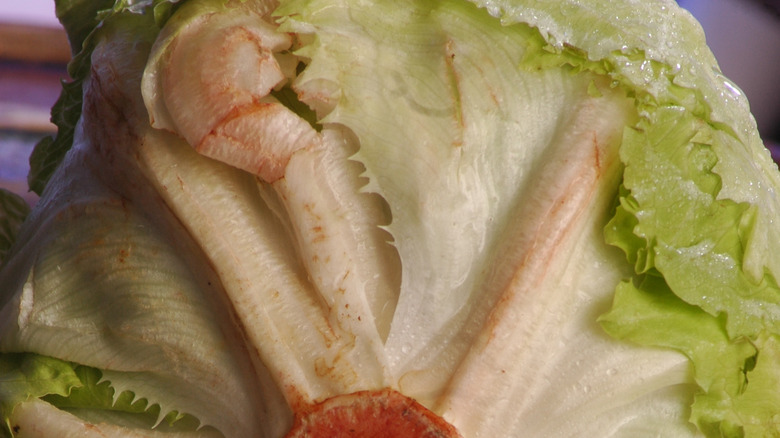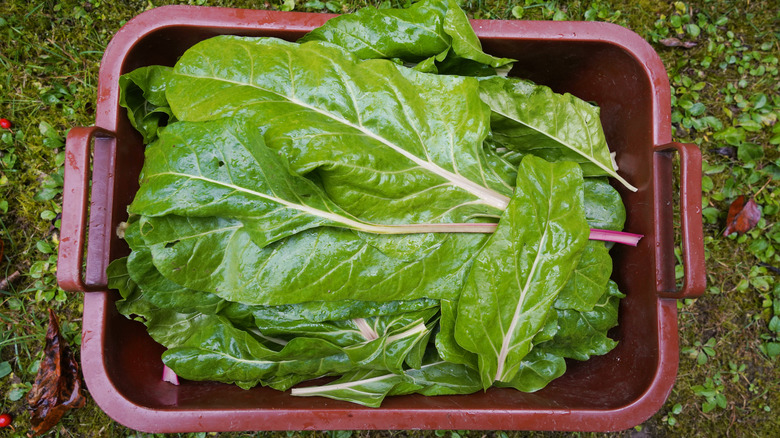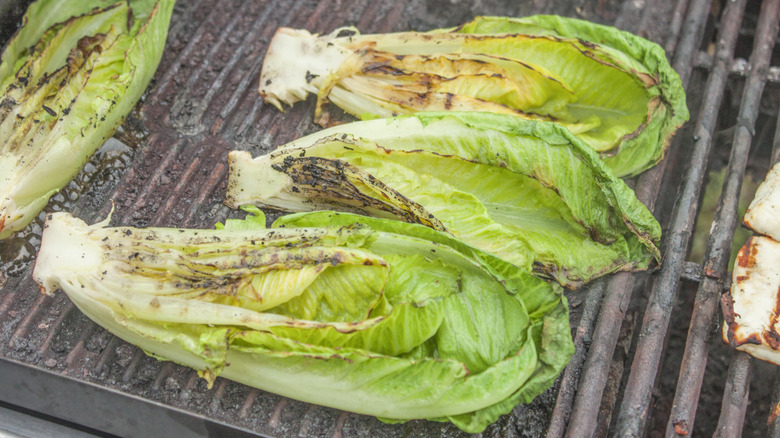The Science Behind Why Your Lettuce Turns Pink And If Its Safe To Use
Let us take a moment to appreciate lettuce. Even if you're not an avid consumer of the endless variations of the classic cold salad, you'll see this crunchy, cool-season crop in American-style tacos and deli sandwiches across the country. You can't make a BLT without the titular lettuce, and a Caesar salad certainly wouldn't be the same without it. As an ingredient, however, lettuce can be a little less than user-friendly.
It's known to be mild and bland to the point of culinary criticism. Some despise the limp, soggy mess it becomes on a cheeseburger, but most frequently, lettuce's issues come from its perishability. It doesn't keep as well as other less leafy vegetables. Over time, a lot can go wrong with what started as a bunch of tightly-packed, crisp green leaves. You might encounter areas of red or pink on the otherwise green lettuce, usually near the roots and ribs. Here's what that coloring really is and what to do about it.
It's rust, and it's fine
Experts in the culinary world know the "rusting" or "pinking" of lettuce is often the result of it being too wet when it's stored. While they add that the rust is totally fine to eat, you can always remove the reddish blemishes or edges with a knife for aesthetic purposes — but if the lettuce isn't going bad, what's going on here? As it turns out, the reddening occurs when the lettuce releases specific compounds as a stress response. It creates a chemical reaction that, in high enough volumes, turns that lettuce into an unappealing but completely harmless color.
This explains why lettuce that's been broken or cut and then stored (or otherwise "wounded") is often the first to go pink. If you've ever blushed in a humiliating situation, maybe you should sympathize with the green stuff. If the lettuce is around a lot of ethylene — a gas produced in abundance by fruits like bananas, apples, peaches, and tomatoes — it can quicken the rusting effect.
How to cook with rusted lettuce
If you're shopping for lettuce and see a little pink discoloration, don't worry about it! You'll know spoiled lettuce when you see (and smell) it. FoodPrint explains that the outside leaves of lettuce heads (versus loose-leaf lettuce) shouldn't be eaten. If they're not in the best shape, you can still buy the lettuce as long as the inner leaves aren't brown, slimy, or wilted. Some lettuce is even supposed to be red or purple; there are many unique varieties out there — not just romaine and iceberg.
There are ways to keep your lettuce rust-free at home as well. Most importantly, try to keep it as dry as possible — it's best to avoid washing lettuce until right before it's used to control the moisture level (and therefore, rust) and deter bacterial growth. Also, store it away from ethylene-producing fruits. Of course, pink doesn't necessarily mean pretty when it comes to lettuce, so you might want to carefully trim raw rusted lettuce. Might we suggest a cooked lettuce recipe, like grilled romaine hearts with Caesar vinaigrette? Either way, there's no need to waste healthy, crunchy lettuce now that you know the pink stuff is harmless.


